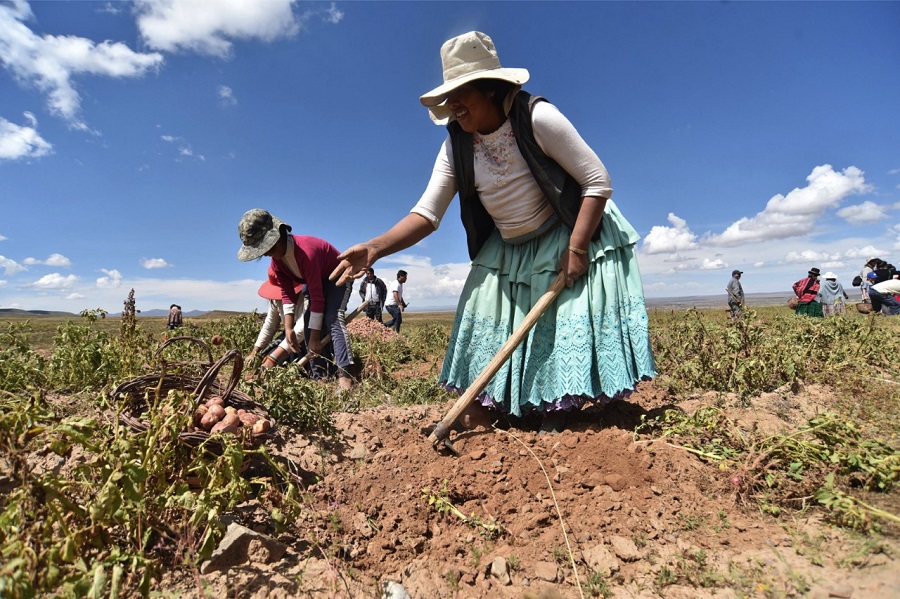RIO DE JANEIRO, BRAZIL – For decades, agribusinesses in eastern Bolivia have claimed that the country’s food security depends on their thousands of hectares primarily planted with corn and soybeans. A recent study by the Peasant Research and Promotion Center (CIPCA) and the Institute for Socio-Economic Research (IISEC) showed that 61% of the food consumed in the country is the product of peasant family farming.
According to the research, agribusiness produces only 1% of what is eaten in Bolivian homes. The remainder is exported: 38% corresponds to food from abroad, mostly from Peru. A large part is smuggled.

CIPCA director Pamela Cartagena said that smuggling discourages food production in Bolivia. “As there is no market regulation, many communities, particularly in the highlands of La Paz, have stopped producing potatoes and tunta, which was a specialty of this region.”
For Peruvian products to be competitive, governments in the last few years developed an extensive irrigation system.
“In the strip [of Peru] that runs from Puno to Juliaca, all production is irrigated, as a matter of public policy. This in itself increases productivity by two to five times,” Cartagena said.
And she highlighted that on the Peruvian side “they employ agroecological management and use chemical fertilization. Irrigation allows this, because the soils are not patch burned and productivity increases.” In this respect, she noted that if Bolivia yields 5 tons of potatoes per hectare, Peru yields 17 tons in the same area, while Chile harvests 19 tons.
Economist Carola Tito Velarde and IISEC director Fernanda Wanderley are the authors of the research “Contribution of indigenous peasant family farming to food production and consumption in Bolivia,” published by CIPCA this year.
Tito Velarde said that in her study “we identified how much households demand in volume of different products of the basic food basket, such as vegetables, fruits and family farming products.”
She said that “from this balance, we see that family agriculture contributes 61% of fresh products to the basic food basket”. The economist pointed out that “interestingly, only 1% is contributed by non-family agriculture, which is highly technified and does not use family labor,” known as agribusiness.
The CIPCA and IISEC study – of the Bolivian Catholic University – was largely based on data from the National Statistics Institute (INE), according to which there are over 870,000 family farms in Bolivia. Considering that an average of 4 members of the same household work in each of them, this means that they employ 3.2 million people. One third of the total Bolivian population – both active and inactive in the labor market – which is estimated at 11.5 million people.
MYTH OF EMPTY COMMUNITIES
Just as there is the myth that lowland agribusiness feeds the country, there is also the idea that Bolivia’s indigenous peasant communities have fewer inhabitants than years ago.
“Although the ruralists’ studies indicate that there is an exodus from the countryside to the city, the fact that 50 years ago the rural Bolivian population represented 70% of the total population is always mentioned. And today it is only 30%, according to the census,” Cartagena said.
But “that population in absolute terms has not decreased. The percentage has, but in absolute terms the population in the countryside has continued to grow,” albeit much more in the cities.
In addition, in recent decades there has been a growing phenomenon: double residence. A significant share of the rural population also lives in the cities. Cartagena believes that the next census, to be conducted in 2022, should include a specific question to clarify this issue.
The CIPCA director said that over the years the communities have been allocating a greater part of their production to the market. “Between 60 and 55% of family production is destined for the market, while between 40 and 45% is for self-consumption.”
In addition to demonstrating the contribution of peasant families to the basic food basket, the study “also shows that many family farming products generate surpluses that cannot be marketed. We believe that this is due to the distance and connectivity to the different markets.”
In many communities, oranges and mangoes “are given to pigs, because the roads become difficult at harvest time. There is no promotion for this type of production,” Cartagena said. And she said that “government policies are more geared towards favoring agribusiness.”
The CIPCA director hopes that this study will lead to a dialogue with the government on policies for family farmers: “We want to determine how much money is allocated to family farming, and not only think about subsidizing the diesel used by agribusiness.”

